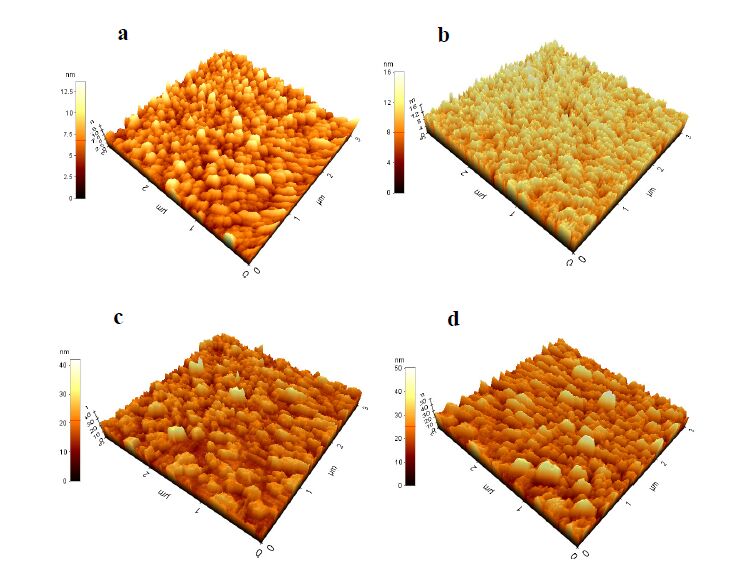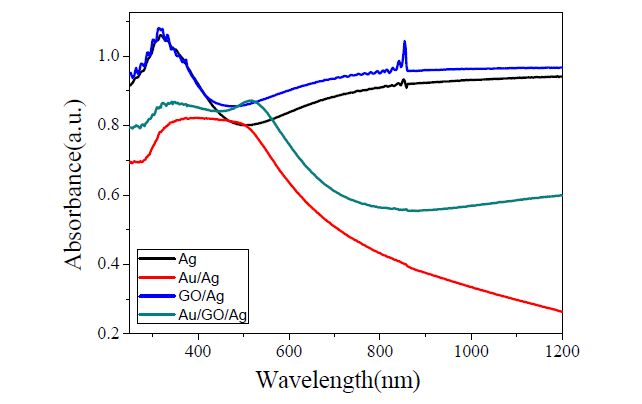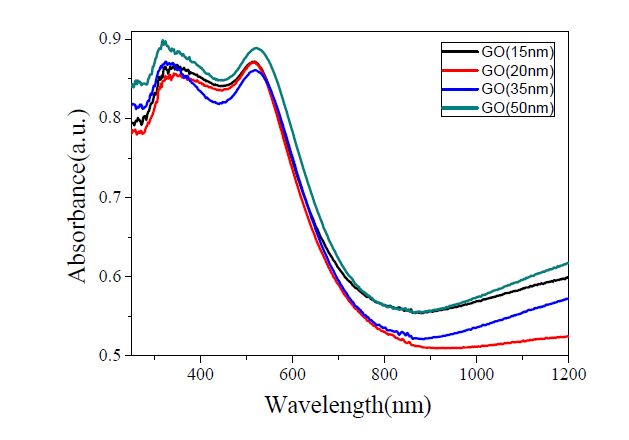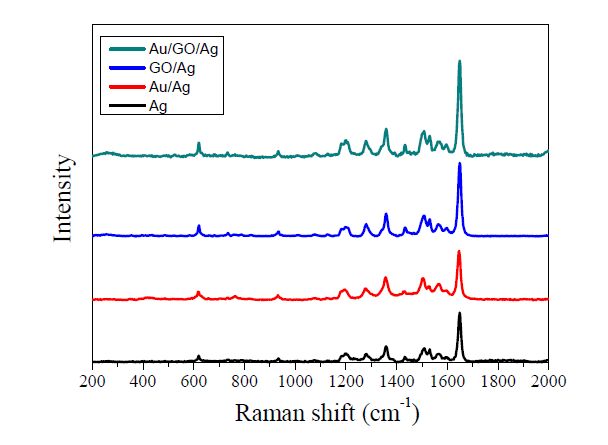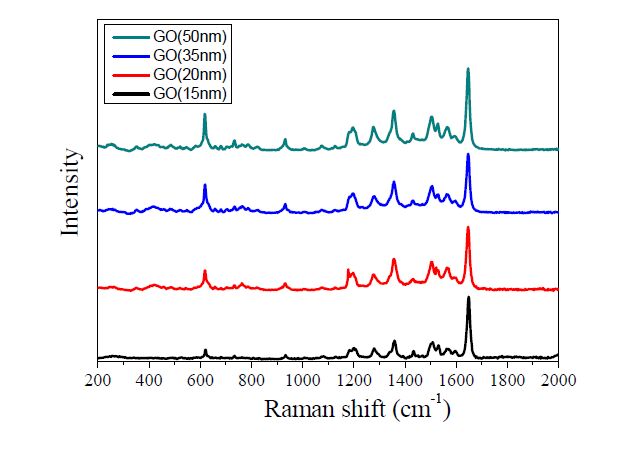1. Introduction
Nanostructural metal with strong optical absorption lines due to the excitation of local plasmon resonances has potential applications in surface enhanced Raman scattering (SERS) [1,2]. SERS discovered in 1974 [3] has attracted increasing attention as a powerful analytical technique in chemical and biological detections for low concentration molecules, DNA, pathogens, etc [4,5,6]. The vast majority of investigations of SERS have been focused on noble metals, and silver or gold nanostructures with different morphologies are usually selected as the SERS-active substrates for high charge carrier density [7,8].
Compared to gold, silver has a greater enhancement factor. But, its bad chemical stability hinders its long-term use, especially for biomolecule detection [9]. However, the gold film with excellent chemical stability and biocompatibility can be complementary advantage of silver when they form alloy. Various Ag-Au bimetal systems have been designed to tune and broadened plasmon resonance wavelength [10,11,12]. Recent research indicates that coating silver nanoparticles (NPs) with stable materials such as ultrathin diamond-like carbon [13], silica [14], titania [15] and graphene oxide [16] can effectively protect them from being oxidized. Graphene oxide layer deposited on silver, which is due to graphene oxide with fluorescence quenching effect, has the potential advantage as SERS-active substrate [16,17,18,19,20,21].
In this paper, we fabricated Au/graphene oxide/Ag/substrate sandwich structure thin films by a convenient and low-cost method. The width and intensity of surface plasmon resonance (SPR) were adjusted/ tuned by introducing gold-silver alloy and GO between gold and silver layer, respectively.
2. Materials and Method
Both silver and gold films were deposited on silica by magnetron sputtering using silver and gold target (99.99%), respectively. The chamber was evacuated with a base pressure of about 5.0 × 10−4 Pa before the film deposition. Either Au or Ag layer was deposited with the thickness of 5 nm.
GO prepared according to Hummers' method [22] was sonicated for one hour at room temperature in isopropyl alcohol solution to ensure that GO was fully dispersed, forming stable GO colloids. After aging for several hours, the GO colloids were spin-coated onto the silver coated substrates using a spin-coater at 3,000 rpm for 20-30 s. The thicknesses of as-deposited GO layers were 15 nm, 20 nm, 35 nm, and 50 nm, respectively.
The crystal structure of the film was characterized by X-ray diffraction (XRD) using a Bruker AXS/D8 Advance system, with Cu Kα radiation (λ = 0.15408 nm). The optical absorption of the samples was measured with an UV-VIS-NIR double beam spectrophotometer (Lambda 1050, Perkins Elmer). The surface roughness was examined by atomic force microscopy (AFM) (XE-100, Park Systems) with scanning area for 3 µm × 3 µm. Raman Scattering spectra were acquired using a confocal microprobe Raman system (LabRam Aramis, Horiba) operated with a DPSS blue laser (473 nm). The size of laser spot is about 1 μm in diameter. All the measurements were carried out at room temperature.
3. Results and Discussion
XRD patterns as shown in Figure 1 reveal the influence of gold or GO layer on the structure of silver thin film. No diffraction peak can be observed in the silver single layer sample. A diffraction peak at approx. 38.60° (2θ) was detected in the Au-Ag alloy thin film which corresponds to the (111) crystallographic plane of gold (JCPDS: 04-0783). The surface of film tends to be either (111) or (0001) plane because these planes exhibit minimum surface free energies. This means that the (111) textured film must form in an effective equilibrium state where enough surface mobility is given to impinging atoms under a certain deposition condition. According to Figure 1, the GO layer has no obvious effects on the structure of silver or silver-gold alloy.
Figure 2 shows the AFM micrographs with a scanning area of 3 µm × 3 µm obtained from silver thin films, Au/Ag double layer thin films, GO/Ag composite thin films and Au/GO/Ag sandwich structure thin films, respectively. The root-mean-square surface roughness (Rq) values are 1.715, 2.049, 3.375, and 4.199 nm, respectively. The initial value of surface roughness is low due to the smooth substrate. With the Au or GO layer, the grain coarsening or shadowing effects from the top layer increased, resulting in the increasing of surface roughness of thin films. The increase of Rq values are also attributed to the gain boundary between silver and gold layers, GO and metal layer in alloy or composite thin film system.
Optical absorption is very important in characterizing the active substrate for surface-enhanced spectroscopy because it reflects the surface plasma resonance in the films. Figure 3 shows the optical absorption spectra of silver single layer, Au/Ag alloy thin film, graphene oxide/Ag, and Au/graphene oxide/Ag, respectively. According to Figure 3, an absorption peak at approx. 320 nm with a broad shoulder at the low energy side, corresponding to the plasma edge of silver, is observed in single layer silver thin film. The GO covered silver sample exhibits similar optical absorption spectrum to that of single silver layer sample. The optical absorption intensity of graphene oxide/Ag film slightly increases compared to that of single silver on bare silica substrate for the grain boundary in the interface between the surface and top-layer. For the Au-Ag bimetal layer thin films, one SPR absorption peak located between two monometallic SPR peaks was observed. The broadening of optical absorption peak in the Au-Ag bimetallic films was mainly due to the interparticle-coupling-induced enhancement and the SPR absorption peak of Au/Ag bimetallic film predominantly occurred in the Au. With the interlayer graphene oxide, one broadened SPR absorption peak was separated to two, corresponding to Ag and Au respectively. The optical absorption intensity was obviously enhanced with GO as interlayer between gold and silver layers compared to that of gold-silver alloy sample. The absorption intensity increased with the GO layer thickness increasing (as shown in Figure 4).
As a demonstration of the potential application of the proposed Au/GO/Ag thin films, the sample was used as a SERS substrate for probing Rhodamine B (Rh B) molecules (concentration = 0.1 μm). Rh B, a typical artificial dye, was chosen as a test compound for studying the application of Au/GO/Ag thin film to detect trace toxic organic compounds. The Rh B molecule solutions were dosed onto the samples' surfaces. Figure 5 shows the detected SERS spectra of the Rh B molecules on Au/GO/Ag sandwich structure thin films, as well as the reference spectra on Ag thin film, Au-Ag alloy thin film, and GO/Ag thin film surfaces. Three strong Raman bands at about 1648, 1361 and 1504 cm−1, being assigned to the C=C stretching mode of Aromatic rings [23], were obviously observed in all samples.
According to Figure 5, the Raman signal intensity collected from single layer Ag thin film was weak, while the signal intensities were observed to be enhanced slightly for the Au-Ag bimetal sample, GO/Ag samples. The signal intensities were enhanced significantly in the Au/GO/Ag sandwich structure sample, and the Raman intensities of Au/GO/Ag sandwich structure samples increased with the GO layer thickness increasing, as shown in Figure 6.
The SERS enhancement can be principally attributed to the increased absorption of incident light by the GO and metal layers. The results from the SERS experiments are consistent with those of the absorption spectra, verifying that the Au/GO/Ag composite thin film shows a much better SERS performance than that of the smooth surface silver thin film due to stronger field localization and the significant interface enhancement between the GO colloids and the silver thin film. To understand whether the GO can be considered as the origin of this special plasma enhancement, we compared the Raman signals of Rh B molecules dispersed on the surface of a GO-enhanced substrate without a silver thin film layer to those detected for molecules dispersed on the GO/silver thin film. The absorption intensity of the samples increased with the GO thickness over the entire scanning range, and no obvious absorption peaks were observed for all samples, meaning that an individual GO layer was not able to generate the electromagnetic field enhancement. Therefore, the gold/GO/silver thin film has great potential to be used as a low-cost, replicable, high-performance active substrate for SERS applications.
4. Conclusion
We fabricated Au/GO/Ag sandwich structure thin films to realize the optical properties tailoring and energy tuning by introducing bimetal and GO layers, respectively. Compared to that of single layer silver thin films, the optical absorption peak was obviously broadened in the Au-Ag alloy sample, and the optical absorption intensity was obviously enhanced for Au/GO/Ag sample. The corresponding Raman measurement results confirmed its tunable energetics and tailorable optical properties.
Acknowledgments
This work was partially supported by the National key research and development program of China (2016YFB1102303), the National Basic Research Program of China (973Program) (2015CB352001), and National Natural Science Foundation of China (61378060).
Conflict of Interest
All authors declare no conflicts of interest in this paper.









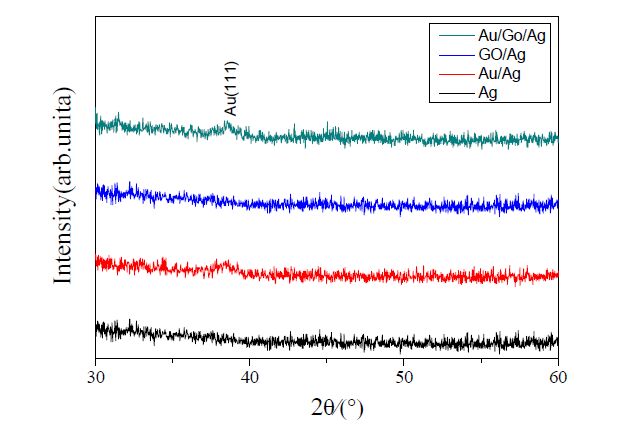
 DownLoad:
DownLoad: 